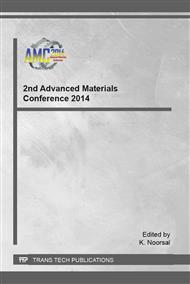[1]
L. Chen, S. Gao, H. Zhang, Performance analysis and multi-objective optimization of an irreversible solid oxide fuel cell-stirling heat engine hybrid system, Int. J. Electrochemical Sci. 8 (2013) 10772.
DOI: 10.1016/s1452-3981(23)13147-6
Google Scholar
[2]
J. Nielsen, P. Hjalmarsson, M.H. Hansen, P. Blennow, Effect of low temperature in-situ sintering on the impedace and the performance of intemediate temperature solid oxide fuel cell cathodes, J. Power Sources. 245 (2014) 418.
DOI: 10.1016/j.jpowsour.2013.06.067
Google Scholar
[3]
H.A. Rahman, A. Muchtar, N. Muhamad, H. Abdullah, La0. 6Sr0. 4Co0. 8O3-δ-SDC carbonate composite cathode for low temperature solid oxide fuel cells, Mat. Chemistry and Physics. 141 (2013) 752.
DOI: 10.1016/j.matchemphys.2013.05.071
Google Scholar
[4]
F. Meng, T. Xia, J. Wang, Z. Shi, J. Lian, H. Zhao, J. -C. Grenier, Evaluation of layered perovskites YBa1-xSrxCo2O5+δ as cathodes for intermediate-temperature solid oxide fuel cells, Int. J. Hydrogen Energy 39 (2014) 4531.
DOI: 10.1016/j.ijhydene.2014.01.008
Google Scholar
[5]
L. Agun, H.A. Rahman, S. Ahmad, A. Muchtar, Durability and stability of LSCF composite cathode for intermediate-low temperature of solid oxide fuel cell (IT-LT SOFC), Trans Tech Publications, (2014).
DOI: 10.4028/www.scientific.net/amr.893.732
Google Scholar
[6]
S.A. Muhammed Ali, A. Muchtar, A. Bakar Sulong, N. Muhamad, E. Herianto Majlan, Influence of sintering temperature on the powder densiti of samarium-doped-ceria carbonate electrolyte composites for low temperature solid oxide fuel cells, Ceramics Int. 5813 (2013).
DOI: 10.1016/j.ceramint.2013.01.002
Google Scholar
[7]
M. Ghouse, Y. Al-Yousef, A. Al-Musa, M.F. Al-Otaibi, Preparation of La0. 6Sr0. 4Co0. 2Fe0. 8O3 nanoceramic cathode powders for solid oxide fuel cell (SOCF) application, Int. J. Hydrogen Energy 9411–9419 (2010) 35.
DOI: 10.1016/j.ijhydene.2010.04.144
Google Scholar
[8]
H. A, Rahman, A. Muchtar, N. Muhamad, H. Abdullah, Structure and thermal proporties of La0. 6Sr0. 4Co0. 2Fe0. 8O3-δ-SDC carbonate composite cathods for intermediate-to low-temperature solid oxide fuel cells, Ceramics Int. 38 (2012) 1571.
DOI: 10.1016/j.ceramint.2011.09.043
Google Scholar
[9]
V. Singh, S. Babu, A.S. Karakoti, A. Agarwal, S. Seal, Effect of submicron grains on ionic conductivity of nanocrystalline doped ceria, J. Nanoscience and Nanotechnology 10 (2010) 6495.
DOI: 10.1166/jnn.2010.2523
Google Scholar
[10]
R.V. Mangalaraja, S. Ananthakumar, A. Schachtsiek, M. López, C.P. Camurri, R.E. Avila, Synthesis and mechanical properties of low temperature sintered Sm3+ doped nanoceria electrolyte membranes for IT-SOCF applications, Mater. Sci. & Eng. A. 527 (2010).
DOI: 10.1016/j.msea.2010.01.025
Google Scholar
[11]
X. Sha, Z. Lü, X. Huang, J. Miao, L. Jia, X. Xin, W. Su, Preparation and properties of rare earth co-doped Ce0. 8Sm0. 2-xYxO1. 9 electrolyte materials for SOCF, J. Alloys and Compounds 424 (2006) 315.
DOI: 10.1016/j.jallcom.2005.12.061
Google Scholar
[12]
K.C. Anjaneya, G.P. Nayaka, J. Manjanna, G. Govindaraj, K.N. Ganesha, Studies on structural, morphological and electrical properties prepared by citrate complexation method, J. Alloys and Compounds 585 (2014) 594.
DOI: 10.1016/j.jallcom.2013.09.101
Google Scholar
[13]
J. Raharjo, A. Muchtar, W. Ramli, W. Daud, N. Muhamad, E. Herianto, Porous NiO-SDC carbonates composite anode for LT-SOFC applications produced by pressureless sintering, Trans Tech Publications, (2011).
DOI: 10.4028/www.scientific.net/amm.52-54.488
Google Scholar
[14]
Y. Liu, F. Wang, B. Chi, J. Pu, L. Jian, S.P. Jiang, A stability studyof impregnated LSCF-GDC composite cathodes of solid oxide fuel cells, J. Alloys and Compounds 578 (2013) 37.
DOI: 10.1016/j.jallcom.2013.05.021
Google Scholar
[15]
L. Da Conceição, A.M. Silva, N.F.P. Ribeiro, M.M.V.M. Souza, Combustion synthesis of La0. 7Sr0. 3Co0. 5Fe0. 5O3 (LSCF) porous materials for application ascathode in IT-SOFC Mat. Res. Bulletin 46 (2011) 308.
DOI: 10.1016/j.materresbull.2010.10.009
Google Scholar


